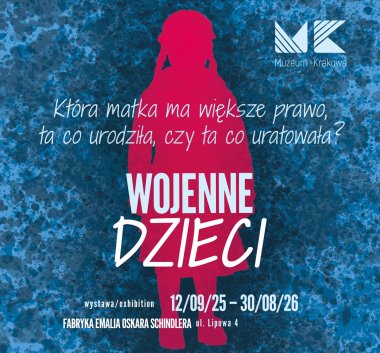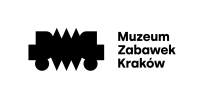Children of War
12.09.2025
- 30.08.2026

Exhibition curator
Beata Łabno
The Children of War exhibition will be presented at Oskar Schindler’s Emalia Factory, a place of living memory, immensely important to the history of Krakow during World War II.
Organized by the Museum of Krakow (Oskar Schindler’s Factory Branch), the exhibition faces the difficult challenge of trying to show the war and occupation from the perspective of children who were no more than 11 years old when the war broke out on 1 September 1939.
The micro-stories of more than a dozen characters – who differ in terms of their cultural background, national affiliation, religion, social and economic status – form a broad landscape of personal experiences and behaviour of children of war.
With the exhibition, we want to change previous perceptions of children – so that we see them not only and exclusively as victims, but also as active subjects and addressees of adults’ actions. We want to show their role in those cruel times, their agency – even if it was dependent on the agency of adults. We also want to show their mutual relations with adults, closer and distant family, and finally strangers. Out of respect for the characters and to provide a full picture of their wartime fate, we will also show, albeit in an abbreviated form, their pre-war and post-war stories.
Most of the characters in the exhibition survived the war, but it left an indelible mark on them – they were marked for life by mental and physical suffering.
The exhibition is multi-threaded and based on a broad spectrum of text and graphic sources, from photographs, to drawings and accounts, to recorded audio and video memories created just after the war and later, in our times. We will also show – which is extremely valuable for a museum exhibition – artifacts belonging to the characters or artifacts from the period illustrating the fate of the characters. The archival materials and artifacts come from state archives and private collections from Poland, England and Israel.
The titles of the parts of the exhibition (and at the same time the topics covered) are: From playing to clandestine activities; Normal life; Home as a shelter, home as threat; On the Aryan side; Prisoners of camps; Deportees; and Traces of life and memory (the part dedicated to children who did not survive the war). The last part of the exhibition is called Children document and presents a shocking picture of the war and occupation based on children’s accounts and drawings.
Finally, we ask questions: Are we really giving children the best we have to give today? Are we giving it to all children?
These questions are a paraphrase of a provision from the 1924 Declaration of the Rights of the Child adopted by the League of Nations General Assembly, which reads ‘mankind owes to the Child the best that it has to give … beyond and above all considerations of race, nationality or creed’.
The exhibition will be accompanied by two books: for adults and for children.
The book for children, entitled Szkatułka. Pierrot. Piłeczka [Case. Pierrot. Little ball], consists of three stories, written by Joanna Rudniańska, an author specializing in children’s literature. The stories, accompanied by illustrations by Igor Kubik, are based on the fate of two characters of the Children of War exhibition and a persona created by the writer referring to the current war in Ukraine. Parents and children are encouraged to read the book together or listen to it as a radio play at the exhibition.
The exhibition will also be accompanied by a rich educational programme, tailored for all age groups, including persons with special needs.
The micro-stories of more than a dozen characters – who differ in terms of their cultural background, national affiliation, religion, social and economic status – form a broad landscape of personal experiences and behaviour of children of war.
With the exhibition, we want to change previous perceptions of children – so that we see them not only and exclusively as victims, but also as active subjects and addressees of adults’ actions. We want to show their role in those cruel times, their agency – even if it was dependent on the agency of adults. We also want to show their mutual relations with adults, closer and distant family, and finally strangers. Out of respect for the characters and to provide a full picture of their wartime fate, we will also show, albeit in an abbreviated form, their pre-war and post-war stories.
Most of the characters in the exhibition survived the war, but it left an indelible mark on them – they were marked for life by mental and physical suffering.
The exhibition is multi-threaded and based on a broad spectrum of text and graphic sources, from photographs, to drawings and accounts, to recorded audio and video memories created just after the war and later, in our times. We will also show – which is extremely valuable for a museum exhibition – artifacts belonging to the characters or artifacts from the period illustrating the fate of the characters. The archival materials and artifacts come from state archives and private collections from Poland, England and Israel.
The titles of the parts of the exhibition (and at the same time the topics covered) are: From playing to clandestine activities; Normal life; Home as a shelter, home as threat; On the Aryan side; Prisoners of camps; Deportees; and Traces of life and memory (the part dedicated to children who did not survive the war). The last part of the exhibition is called Children document and presents a shocking picture of the war and occupation based on children’s accounts and drawings.
Finally, we ask questions: Are we really giving children the best we have to give today? Are we giving it to all children?
These questions are a paraphrase of a provision from the 1924 Declaration of the Rights of the Child adopted by the League of Nations General Assembly, which reads ‘mankind owes to the Child the best that it has to give … beyond and above all considerations of race, nationality or creed’.
The exhibition will be accompanied by two books: for adults and for children.
The book for children, entitled Szkatułka. Pierrot. Piłeczka [Case. Pierrot. Little ball], consists of three stories, written by Joanna Rudniańska, an author specializing in children’s literature. The stories, accompanied by illustrations by Igor Kubik, are based on the fate of two characters of the Children of War exhibition and a persona created by the writer referring to the current war in Ukraine. Parents and children are encouraged to read the book together or listen to it as a radio play at the exhibition.
The exhibition will also be accompanied by a rich educational programme, tailored for all age groups, including persons with special needs.

Exhibition curator
Beata Łabno











